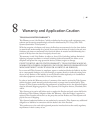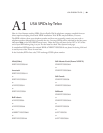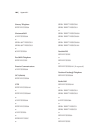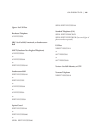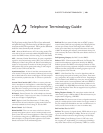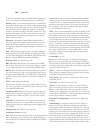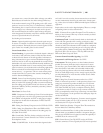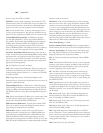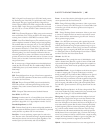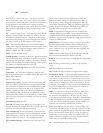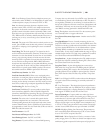GUIDE TO TELEPHONE TERMINOLOGY | 103
You’ll get better results from the Telco if you understand
and speak the lingo! We have tried to include the typical
acronyms used by Telco personnel. We’ve put the definition
under the most commonly used acronyms.
AMI – Alternate Mark Inversion. A T1 line coding method. is
is the older of the two commonly available. Modified AMI is also
used on the ISDN S interace. See line coding, T1. See Also B8ZS.
ANI – Automatic Number Identification- A system, originally de-
signed for use by Interexchange carriers (IECs), that transmits the
“billed party number” along with a call. Note that the billed party
number is not necessarily the number of the line placing the call.
ANI predates SS7 and can operate with analog as well as digital
trunks. See also CLID and Caller ID.
Asynchronous Data - A form of serial data communication that
is not clocked. To keep the bit stream synchronized, start and stop
bits are added, which cuts down on throughput. RS-232 computer
data is commonly asynchronous data. In contrast to synchronous
data.
Acoustic Echo Canceller (AEC)- When an acoustic path exists
from a microphone to a loudspeaker in a teleconferencing applica-
tion, the far-end participant will hear his voice coming back after a
delay. is echo is annoying and can disrupt conversation. An AEC
is a signal processing function that works to remove this echo.
B Channel - Bearer Channel. One of the multiple user channels
on an ISDN circuit. Used to carry user’s data; i.e. coded audio data
in the case of Zephyr or ZephyrExpress.
B8ZS- Bipolar 8 (with) Zero Substitution. A T1 line coding
method. is is the more modern line coding method of the two
commonly available. See Line Coding, T1. See also AMI
Bearer Channel- See B Channel
Behind the PBX- is is our own term, and refers to when one
privately owned phone system is tied to another privately owned
phone system. e most common application is when a key system
is connected to analog ports of a PBX. When it involves one PBX
behind another, it is a limited Tandem application. See Tandem
Switch and Tandem Tie Trunk Switching below.
Bell Labs. e basic research facility that was AT&T’s primary
research facility. Bell Labs was originally part of Western Electric
and was spun off with Lucent Technologies when AT&T was
broken up in 1984. Many very important discoveries were made
at Bell Labs including the transistor, communications theory, and
radio astronomy. e future of Bell Labs seems bleak at the time of
this writing.
Bell Operating Company. See BOC. See also RBOC.
Bellcore- BELL COmmunications REsearch. See Telcordia. e
research and development organization owned by the RBOCs.
Bellcore represents the RBOCs in developing standards for Telco
equipment and in testing equipment compliance to those standards.
Bellcore also offers educational and training programs open to all
interested parties. Now Telcordia.
BERT - 1) Bit Error Rate Test- A test for digital lines which in-
volves looping a data path and sending a test pattern. Data return-
ing is compared to the sent data to check for errors. Depending on
the “Test Pattern” used, BERTs may or may not uncover problems.
A line, which only has occasional problems, will need a BERT of
sufficient time duration to catch that intermittent problem. A five
minute BERT of an ISDN BRI circuit will only catch severe prob-
lems. 2) Bit Error Rate Tester. e test equipment used to perform a
Bit Error Rate Test.
Billing Telephone Number- e main phone number which all
calls on hunt group or a PRI are billed to. is information may be
required when configuring a PRI PBX.
Bit Error Rate- e basic measure of errors on digital transmission
paths. It is usually expressed as the number of errors per number of
bits. For example, the allowable bit error rate on a BRI circuit is 1 x
10 E7 (one bit error in 107 bits or 1 error in 10 million bits).
Bit Error Rate Test-See BERT
Bit Rate- e capacity of a digital channel. ISDN calls are set up at
a given bit rate, either 64Kbps or 56Kbps. e bit rate of a circuit-
switched connection cannot be changed during a call. See Kbps.
BLEC- Building Local Exchange Carrier. A LEC who covers
the occupants of a single building (or a small group of buildings)
only. Often Telecom services are provided by a BLEC as a service
A2
Telephone Terminology Guide





